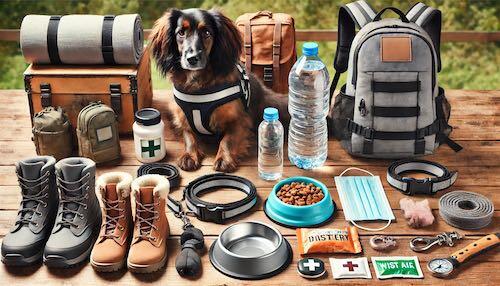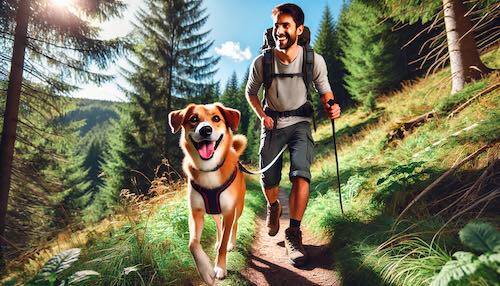The Ultimate Guide to Hiking with a Dog: Tips, Gear, and Trails
Introduction
Hiking with a dog is an incredible way to bond, explore the great outdoors, and keep both you and your furry friend healthy and happy. Whether you’re an experienced hiker or a novice looking to start a new adventure with your dog, this guide will provide you with all the necessary tips, gear recommendations, and trail suggestions to ensure you and your canine companion have a safe and enjoyable experience on the trails.
Search: Best Selling Dog Hiking Equipment Online Here
There’s something uniquely satisfying about sharing the beauty of nature with your dog. Dogs are natural explorers, and the joy they exhibit while discovering new scents, sights, and sounds can make any hike more enjoyable. Moreover, hiking offers a great way to maintain both your and your dog’s physical health. Regular exercise helps to manage weight, improve cardiovascular health, and strengthen muscles.
Beyond the physical benefits, hiking can also improve your dog’s mental health. The variety of stimuli in natural settings keeps their minds sharp and reduces boredom, which can lead to behavioral issues at home. For humans, spending time in nature is a known stress reliever, enhancing mental well-being and providing a break from the routine.
This guide aims to be a comprehensive resource, covering everything from preparing for your hike to selecting the right gear, training tips, safety considerations, and even a list of top dog-friendly trails across the United States. Whether you’re planning a short walk through a local park or a multi-day backcountry adventure, you’ll find valuable insights to make your hikes with your dog safe and enjoyable.
Preparing for the Hike
Assessing Your Dog’s Fitness and Health
Before hitting the trails, it’s important to evaluate your dog’s fitness level and overall health. Consider their age, breed, and any pre-existing health conditions. Schedule a vet visit to ensure your dog is physically capable of handling the hike. Some breeds are naturally more suited for long treks, while others may require more conditioning.
Puppies and senior dogs might need extra attention. Puppies are full of energy but can easily overexert themselves, while older dogs might have joint issues or reduced stamina. Your veterinarian can provide tailored advice on what kind of physical activity is appropriate and how to build up your dog’s endurance gradually.
Choosing the Right Trails
Not all trails are created equal when it comes to hiking with dogs. Start with shorter, easier trails to gauge your dog’s endurance and gradually increase the difficulty. Look for trails that offer shade, water sources, and gentle terrain. National parks, state parks, and local nature reserves often have designated dog-friendly trails.
Consider the type of terrain your dog will be hiking on. Soft, natural surfaces like dirt or grass are preferable to rocky or paved paths, which can be hard on your dog’s paws. Steep inclines and declines can be challenging for dogs, especially those not used to such terrain. Also, check for trails that have natural water sources, like streams or lakes, where your dog can cool off.
Researching Trail Regulations and Dog-Friendly Policies
Each hiking area has its own rules regarding dogs. Some trails require dogs to be leashed at all times, while others might have off-leash areas. Always check the specific regulations of the trail you plan to visit to avoid fines and ensure a positive experience for everyone on the trail.
Some areas have restrictions during certain times of the year due to wildlife activity or breeding seasons. Understanding these rules helps protect the local ecosystem and ensures that you and your dog have a pleasant experience. Additionally, some trails require permits or have limited access, so plan ahead to secure any necessary permissions.
Checking the Weather
Weather conditions can significantly impact your hiking plans. Avoid extreme temperatures, and be mindful of how weather changes can affect your dog’s comfort and safety. Hot weather can lead to overheating and dehydration, while cold weather might require additional protective gear for your dog.
Dogs can suffer from heatstroke just like humans, so it’s crucial to plan hikes during cooler parts of the day, especially in the summer. In winter, dogs with thin coats may need extra insulation like dog jackets. Always check the weather forecast before heading out and be prepared to adjust your plans if conditions are not favorable.

Essential Gear for Hiking with Dogs
Leashes and Harnesses
A sturdy leash and a comfortable, well-fitted harness are essential for controlling your dog on the trail. Consider a hands-free leash for more convenience. Reflective gear is also useful for visibility in low-light conditions.
A hands-free leash, which attaches around your waist, allows for better balance and frees up your hands. Choose a leash with a bit of elasticity to absorb any sudden pulls. Reflective gear is crucial if you’re hiking early in the morning or late in the evening. It enhances your dog’s visibility to other hikers, bikers, and vehicles.
Collapsible Water Bowls and Hydration Packs
Keeping your dog hydrated is crucial. Bring along collapsible water bowls and a hydration pack to ensure your dog has access to water throughout the hike. Plan for frequent water breaks, especially in hot weather.
Collapsible water bowls are lightweight and easy to carry. Some hydration packs for dogs come with built-in water storage, allowing your dog to carry their own water. Ensure that any water source you encounter on the trail is safe for your dog to drink from, or bring enough water for both of you.
Dog Backpacks
If your dog is physically capable, a dog backpack can help distribute the load and allow them to carry their own gear, such as water, snacks, and waste bags. Make sure the backpack fits properly and doesn’t exceed 10-15% of your dog’s body weight.
Dog backpacks come in various sizes and designs. Choose one that fits well and doesn’t restrict your dog’s movement. Start by having your dog wear the backpack on short walks to get them accustomed to it before venturing out on longer hikes.
Protective Gear
Booties can protect your dog’s paws from rough terrain, hot surfaces, and sharp objects. Cooling vests are great for hot weather hikes, helping to regulate your dog’s body temperature. Always test new gear at home to ensure your dog is comfortable wearing it.
Booties not only protect against hot pavement or rocky paths but also against snow and ice in winter. Cooling vests can be soaked in water before the hike, providing evaporative cooling. Make sure your dog is comfortable in these items by introducing them gradually during your daily walks.
First Aid Kit for Dogs
A first aid kit tailored for dogs is a must-have. Include items like bandages, antiseptic wipes, tweezers, and a digital thermometer. Familiarize yourself with basic first aid procedures for common hiking injuries.
Accidents can happen, so being prepared with a first aid kit can make a big difference. Include a canine-specific guide to first aid and ensure you know how to use each item. Consider taking a pet first aid course for more comprehensive knowledge.
Dog-Friendly Insect Repellent and Sunscreen
Protect your dog from pests and sunburn with products specifically designed for canine use. Avoid human insect repellents and sunscreens, as they can be harmful to dogs.
Ticks, fleas, and mosquitoes can be a nuisance on the trail. Use insect repellents that are safe for dogs and check your dog thoroughly after the hike for any pests. Similarly, dogs with light or short coats can get sunburned, so apply dog-specific sunscreen to vulnerable areas.
Search: Specific Breed Dog Training Guides Here
Training Your Dog for the Trail
Basic Commands
Ensure your dog is well-versed in basic commands like sit, stay, and come. These commands are crucial for maintaining control and ensuring your dog’s safety on the trail.
Commands such as “leave it” and “drop it” are particularly useful on trails to prevent your dog from picking up or eating something harmful. Regular training sessions, both at home and in different environments, help reinforce these commands.

Trail-Specific Training
Train your dog to walk at your side (heel) and to ignore distractions (leave it). Practice these commands in various environments to build reliability.
Teaching your dog to heel is vital for maintaining control, especially on narrow or crowded trails. Use positive reinforcement techniques to reward your dog for good behavior. Practicing in different settings helps your dog stay focused despite various distractions.
Socialization
Expose your dog to different people, dogs, and environments to ensure they remain calm and well-behaved on the trail. Positive reinforcement techniques can help reinforce good behavior.
Socialization is key to preventing anxiety and aggression. Introduce your dog to other hikers, children, cyclists, and other dogs in a controlled manner. This helps your dog become accustomed to different scenarios they may encounter on the trail.
Acclimatizing to Different Terrains
Gradually introduce your dog to different types of terrain, such as rocky paths, grassy fields, and muddy trails. This will help them build confidence and adapt to the varying conditions they’ll encounter on hikes.
Different terrains can present unique challenges for dogs. Start with short walks on various surfaces to get your dog used to them. Gradually increase the difficulty to ensure your dog is comfortable and confident on all types of trails.
On the Trail: Tips and Best Practices
Keeping Your Dog on a Leash
Always keep your dog on a leash unless you’re in a designated off-leash area. This helps protect wildlife, other hikers, and your dog from unexpected dangers.
Leashes prevent your dog from wandering off, chasing wildlife, or approaching other hikers uninvited. Even in off-leash areas, it’s essential to keep your dog within sight and under voice control. Respecting leash laws ensures a safe and enjoyable experience for everyone on the trail.
Managing Trail Etiquette
Practice good trail etiquette by yielding to other hikers, keeping noise levels down, and cleaning up after your dog. Respecting the trail and other users ensures a positive experience for everyone.
Yield to uphill hikers and those moving faster than you. Keep your dog close when passing others and be courteous to fellow trail users. Minimize disturbances by keeping noise levels down and respecting wildlife.
Recognizing Signs of Fatigue or Distress
Pay close attention to your dog’s behavior. Signs of fatigue or distress include excessive panting, limping, or reluctance to continue. Take breaks as needed and be prepared to cut the hike short if necessary.
Dogs can’t verbally communicate when they’re tired or in pain, so it’s crucial to watch for non-verbal cues. Provide ample rest breaks and monitor your dog’s condition throughout the hike. Be ready to carry your dog back if they become too tired or injured to continue.
Hydration and Snack Breaks
Regular breaks for water and snacks help maintain your dog’s energy levels and prevent dehydration. Pack dog-friendly snacks that are easy to carry and provide a quick energy boost.
Offer water every 30 minutes or so, more frequently in hot weather. Healthy snacks like dog biscuits, jerky treats, or specially formulated hiking snacks for dogs can help keep their energy up. Avoid giving your dog too much food at once to prevent digestive issues.
Waste Disposal and Leave No Trace Principles
Pack out all waste, including dog waste. Bring plenty of waste bags and follow Leave No Trace principles to keep the trails clean and enjoyable for everyone.
Always carry enough waste bags and pack out your dog’s waste. Leaving waste on the trail is unsanitary and disrespectful to other hikers and wildlife. Following Leave No Trace principles ensures that natural areas remain pristine and enjoyable for future visitors.
Safety Considerations
Wildlife Encounters
Wildlife encounters can be thrilling but potentially dangerous. Keep your dog close and under control to avoid conflicts with wildlife. Make noise to alert animals of your presence and carry bear spray if hiking in bear country.
Different regions have different wildlife risks. In bear country, make noise to avoid surprising animals and carry bear spray as a precaution. In snake-prone areas, keep your dog on the trail and watch for any signs of danger. Educate yourself about local wildlife and how to handle encounters safely.
Hazardous Plants and Terrain
Be aware of poisonous plants and hazardous terrain that can injure your dog. Learn to identify and avoid these hazards, and steer clear of steep cliffs, unstable rocks, and swift water.
Familiarize yourself with plants like poison ivy, oak, and sumac, which can cause skin irritation. Some wild berries and mushrooms can be toxic to dogs if ingested. Keep your dog away from steep drop-offs, fast-moving water, and unstable surfaces that could cause injury.
Weather-Related Risks
Extreme weather conditions can pose risks to your dog’s health. Be vigilant for signs of heatstroke, hypothermia, and dehydration. Adjust your plans and gear based on the weather forecast.
In hot weather, plan for early morning or late evening hikes to avoid the midday heat. Bring extra water and take frequent breaks in shaded areas. In cold weather, ensure your dog stays warm and dry, and monitor for signs of frostbite or hypothermia. Always be prepared to turn back if conditions become unsafe.
First Aid Tips and Emergency Situations
Knowing basic first aid for dogs can be a lifesaver. Learn how to treat common injuries such as cuts, sprains, and insect bites. Carry emergency contact information for local veterinary services.
Pack a first aid kit with essentials like antiseptic wipes, bandages, and tweezers. Know how to handle situations like cuts, sprains, and insect bites. Having contact information for the nearest veterinary services can be crucial in case of an emergency.
Top Dog-Friendly Trails in the U.S.
Pacific Northwest
Mount Rainier National Park (WA): Features dog-friendly trails with stunning views of Mount Rainier and surrounding forests. Trails like the Wonderland Trail offer diverse landscapes, from dense forests to alpine meadows.
Columbia River Gorge (OR): Offers diverse trails with waterfalls, scenic vistas, and varying levels of difficulty. Trails like the Eagle Creek Trail are popular for their breathtaking views and accessible paths.
Rocky Mountains
Maroon Bells-Snowmass Wilderness (CO): Known for its breathtaking scenery and dog-friendly policies. Trails like the Maroon Lake Scenic Trail offer spectacular views of the Maroon Bells peaks.
Glacier National Park (MT): Provides numerous trails that are perfect for exploring with your dog. Trails like the Avalanche Lake Trail are popular for their beautiful landscapes and moderate difficulty.
Northeast
Acadia National Park (ME): Boasts beautiful coastal trails and plenty of dog-friendly areas. Trails like the Jordan Pond Path offer serene views of the pond and surrounding mountains.
Catskill Mountains (NY): Offers a variety of trails through lush forests and rolling hills. Trails like the Kaaterskill Falls Trail provide scenic waterfall views and moderate hiking challenges.
Southeast
Great Smoky Mountains National Park (NC/TN): Home to a range of trails suitable for dogs and their owners. Trails like the Alum Cave Trail offer unique geological features and beautiful forest scenery.
Shenandoah National Park (VA): Features scenic trails with stunning views of the Blue Ridge Mountains. Trails like the Stony Man Trail are popular for their panoramic vistas and dog-friendly paths.
Southwest
Grand Canyon National Park (AZ): Certain trails are open to dogs, providing unique hiking experiences. Trails like the South Rim Trail offer breathtaking views of the canyon and relatively easy hiking conditions.
Zion National Park (UT): Offers several dog-friendly trails with breathtaking canyon views. Trails like the Pa’rus Trail provide stunning scenery and are accessible for both dogs and their owners.
Conclusion
Hiking with your dog can be a rewarding and enjoyable experience, strengthening your bond and keeping both of you active and healthy. By preparing adequately, investing in the right gear, and following safety guidelines, you can ensure memorable adventures on the trails. Happy hiking!
Remember, each hike is an opportunity to build a deeper connection with your dog while exploring the natural beauty that surrounds you. Embrace the journey, take plenty of pictures, and most importantly, enjoy the shared experiences.
Additional Resources
- Books on hiking with dogs: Titles like “Best Hikes with Dogs” by Karen Sullivan and “Hiking With Dogs: Becoming a Wilderness-Wise Dog Owner” by Linda B. Mullally provide in-depth information and tips.
- Websites and forums for dog-friendly hiking: Websites like BringFido.com and AllTrails.com offer user-generated reviews and information on dog-friendly trails.
- Local hiking groups and clubs: Join local hiking clubs or online groups to connect with other dog owners who share your passion for hiking. Groups often organize hikes and can provide valuable tips and support.
By following the advice in this guide, you and your dog can enjoy many safe and happy trails together. Happy hiking!

